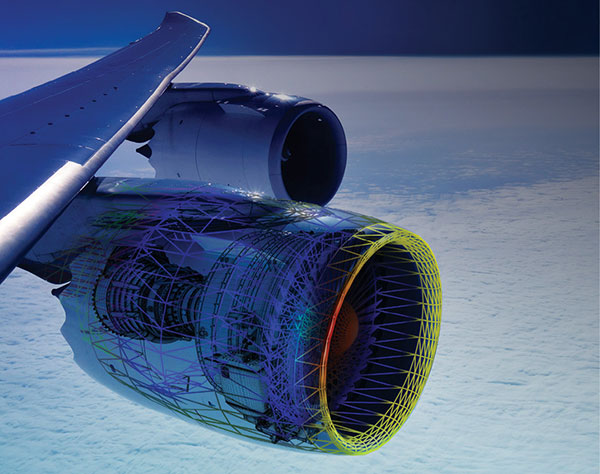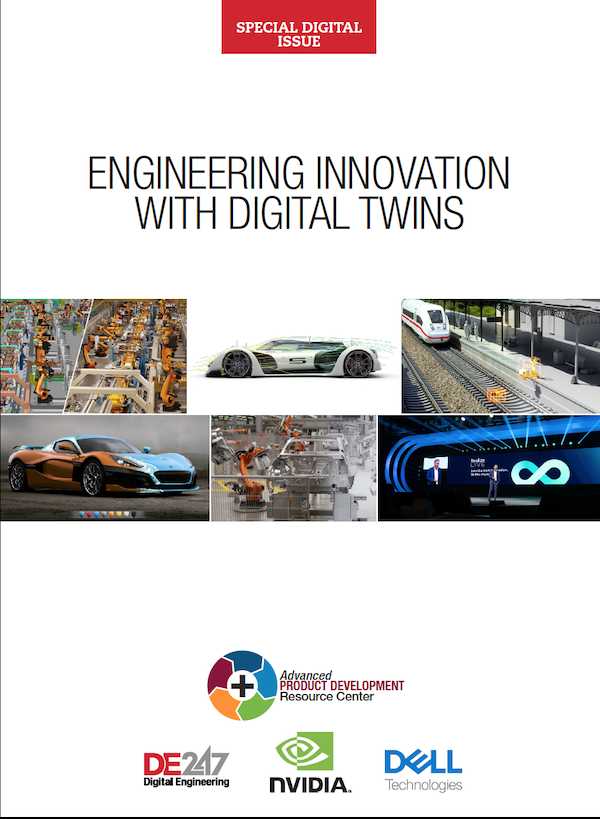Why Digital Twins Need to Call the Cloud Home
The Cloud Connects Real-World Data to Digital Replica

Image courtesy of Rescale.
Latest News
April 26, 2021
If you were a manufacturer assembling a digital twin, what might be the basic components in the kit? This was the hypothetical question that brought together Leo Kilfoy, VP of Smart Factory Platform, Hexagon; Peter Lyu, VP of Global Solutions, Rescale; and Ravi Shankar, Director of Simulation, Siemens Digital Industries Software. The conversation took place as an episode of DE Hot Seat webinar, originally broadcasted on March 25, 2021, sponsored by Hexagon, Rescale, and Siemens.
“A digital twin is a replica of an object, such as a product, system, or machine. Large-scale digital twins can include factories, hospitals, and cities,” defined Kilfoy. “The twin can take real-world data as input and produce predictions based on simulation and analytics.”
Shankar added that the digital twin needs “bidirectional connectivity between the physical asset and the virtual representation. Real-world product performance data can used for simulation; simulation can be used to improve the performance.”
Metrology to Produce Faithful Twins
With this working definition, panelists agreed a digital twin is much more than a detailed 3D model, usually created in CAD software. While a detailed CAD model is sufficient for manufacturing, it does not reflect the real-world conditions (such as the temperature, vibration, and wear and tear) of the operating object in the field. Therefore, a CAD model is severely limited as an entity for predictive study and analysis.
Lyu had just started his career in aerospace engineering when the digital twin concept first emerged, he recalled. The digital twin phenomenon was “partly fueled by the increase performance of simulation, and partly by the adoption of cloud and IOT devices at an industrial scale,” he noted.
Cloud infrastructure, he pointed out, is essential to the setup and maintenance of digital twins as it’s the most affordable network technology to facilitate ongoing bidirectional communication between the equipment in the field and the digital replica.
Kilfoy believes metrology is also a critical component of the digital twin setup. The high-def 3D scans of the parts and products as manufactured more accurately reflect the object destined to be deployed in the field or installed in a factory. They include, for instance, heat-induced deformation to the part that occurred during manufacturing. Therefore, a digital replica constructed from such scans constitutes a superior digital twin than a CAD model.
“Remember: there can be multiple models associated with the digital twin,” said Shankar. “One for thermal performance, one for structural performance, one for electromagnetics, and so on. The key is, the digital twin needs to continuously evolve for different departments.”
The Invisible Cloud Bridge
The obstacle many manufacturers face with their digital twin initiatives is not the digital model but “the deployment of the underlying infrastructure to support the solution, such as the network technologies to stream the real-world data from the IOT device to the central hub, or the HPC resources needed to simulate the virtual model,” said Lyu.
This was the reason that, historically, only large enterprises were able to launch and maintain digital twins. But this may be changing with the more affordable on-demand cloud service providers.
The input required to simulate the digital twin’s behaviors varies based on the characteristics of the product, Kilfoy pointed out. “Consider the digital twin of a fleet of vehicles, as opposed to a living, breathing, evolving factory,” he said. “They have different challenges in traceability.”
For industrial machinery digital twins, recording equipment vibration, rotation, and wear and tear is important. For factory digital twins, capturing the daily processes, operations, and equipment up times and down times are important.
Customizing Twins
Leading public cloud providers are beginning to offer digital twin-related products, Lyu pointed out. Microsoft, for example, offers Azure Digital Twins, described as “an Internet of Things (IoT) platform that enables you to create a digital representation of real-world things, places, business processes, and people.”
“Every digital twin is different so it’s quite a challenge to implement. Each is highly customized, requires special skills and knowledge. That’s the gap that we feel we can fill,” said Lyu.
Rescale counts both MSC Software (part of Hexagon) and Siemens as its partners. These simulations software programs are preloaded in Rescale’s cloud infrastructure. Therefore, Lyu feels Rescale is well-positioned to offer turn-key digital twin solutions.
Because different countries have different regulations for cloud deployment, Rescale has set up different data centers in different regions to comply with the requirements. This too helps eliminate a barrier for digital twin implementation. “Rescale has gone through the certification process, so our customers don’t need to worry about these,” Lyu said.
Predictive models are the outcome of combining physics-based models and real-world data, according to Shankar. With massive real-time data available on certain field devices (for example, hourly temperature readings), it may be wise to employ machine-learning algorithms, such as reduced-order modeling, to keep the input manageable, recommended Lyu.
This Hot Seat episode is available for on-demand viewing. For the link, visit archived episodes at www.digitalengineering247.com/topic/category/webinars, or visit the registration page here.
More Hexagon MSC Software Coverage
More Rescale Coverage

More Siemens Digital Industries Software Coverage
Subscribe to our FREE magazine, FREE email newsletters or both!
Latest News
About the Author
Kenneth Wong is Digital Engineering’s resident blogger and senior editor. Email him at kennethwong@digitaleng.news or share your thoughts on this article at digitaleng.news/facebook.
Follow DE






